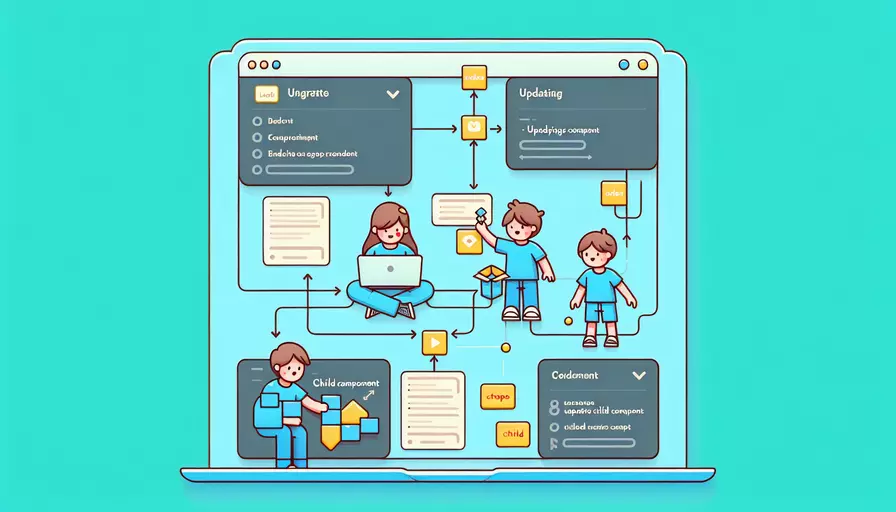
在Vue3中,可以通过多种方式来更新子组件。1、使用Props传递数据,2、使用事件触发更新,3、使用Ref直接访问子组件实例。其中,使用Props传递数据是一种最常见且推荐的方式,因为它遵循了Vue的单向数据流理念。具体地,可以通过父组件的状态变化来驱动子组件的更新。
一、使用Props传递数据
使用Props传递数据是更新子组件的最基本也是最推荐的方式。父组件可以通过改变传递给子组件的Props来触发子组件的重新渲染。
步骤:
- 在父组件中定义一个状态变量。
- 将该状态变量作为Prop传递给子组件。
- 在子组件中使用该Prop,Vue会自动检测父组件状态的变化并重新渲染子组件。
实例说明:
<!-- ParentComponent.vue -->
<template>
<div>
<button @click="updateMessage">Update Message</button>
<ChildComponent :message="message" />
</div>
</template>
<script>
import ChildComponent from './ChildComponent.vue';
export default {
components: {
ChildComponent
},
data() {
return {
message: 'Hello'
};
},
methods: {
updateMessage() {
this.message = 'Hello, Vue 3!';
}
}
};
</script>
<!-- ChildComponent.vue -->
<template>
<div>{{ message }}</div>
</template>
<script>
export default {
props: ['message']
};
</script>
在这个例子中,当用户点击按钮时,父组件的message状态变量会更新,这将自动触发子组件的重新渲染。
二、使用事件触发更新
父组件还可以通过在子组件中触发事件来更新子组件。父组件监听这些事件并根据需要更新状态,从而间接地影响子组件的更新。
步骤:
- 在子组件中通过
$emit触发事件。 - 在父组件中监听该事件。
- 在父组件的事件处理函数中更新状态。
实例说明:
<!-- ParentComponent.vue -->
<template>
<div>
<ChildComponent @update="handleUpdate" />
<p>{{ message }}</p>
</div>
</template>
<script>
import ChildComponent from './ChildComponent.vue';
export default {
components: {
ChildComponent
},
data() {
return {
message: 'Initial Message'
};
},
methods: {
handleUpdate(newMessage) {
this.message = newMessage;
}
}
};
</script>
<!-- ChildComponent.vue -->
<template>
<div>
<button @click="updateParent">Update Parent</button>
</div>
</template>
<script>
export default {
methods: {
updateParent() {
this.$emit('update', 'Updated Message from Child');
}
}
};
</script>
在这个例子中,当子组件触发update事件时,父组件会更新其状态,从而间接地更新子组件。
三、使用Ref直接访问子组件实例
在某些情况下,直接访问子组件的实例可能是必要的。Vue3提供了ref来实现这一功能,允许父组件直接调用子组件的方法或访问其数据。
步骤:
- 在父组件中为子组件设置一个
ref。 - 使用
this.$refs访问子组件实例。 - 通过子组件实例调用其方法或访问其数据。
实例说明:
<!-- ParentComponent.vue -->
<template>
<div>
<button @click="updateChild">Update Child</button>
<ChildComponent ref="childRef" />
</div>
</template>
<script>
import ChildComponent from './ChildComponent.vue';
export default {
components: {
ChildComponent
},
methods: {
updateChild() {
this.$refs.childRef.updateMessage('Updated directly from Parent');
}
}
};
</script>
<!-- ChildComponent.vue -->
<template>
<div>{{ message }}</div>
</template>
<script>
export default {
data() {
return {
message: 'Initial Message'
};
},
methods: {
updateMessage(newMessage) {
this.message = newMessage;
}
}
};
</script>
在这个例子中,父组件通过ref直接调用子组件的方法来更新子组件的状态。
四、使用Vuex进行状态管理
对于更复杂的应用程序,使用Vuex进行全局状态管理是一种更好的选择。Vuex允许在多个组件之间共享和管理状态,从而简化了状态同步和更新。
步骤:
- 安装Vuex并创建一个Vuex store。
- 在store中定义状态和mutation。
- 在组件中通过
mapState和mapMutations访问和更新状态。
实例说明:
// store.js
import { createStore } from 'vuex';
export default createStore({
state: {
message: 'Initial Message'
},
mutations: {
updateMessage(state, newMessage) {
state.message = newMessage;
}
}
});
<!-- ParentComponent.vue -->
<template>
<div>
<button @click="updateMessage">Update Message</button>
<ChildComponent />
</div>
</template>
<script>
import { mapMutations } from 'vuex';
import ChildComponent from './ChildComponent.vue';
export default {
components: {
ChildComponent
},
methods: {
...mapMutations(['updateMessage'])
}
};
</script>
<!-- ChildComponent.vue -->
<template>
<div>{{ message }}</div>
</template>
<script>
import { mapState } from 'vuex';
export default {
computed: {
...mapState(['message'])
}
};
</script>
在这个例子中,父组件通过Vuex的mutation来更新全局状态,子组件通过Vuex的state来访问更新后的状态。
五、比较不同方法的优缺点
| 方法 | 优点 | 缺点 |
|---|---|---|
| Props传递数据 | 简单、符合Vue单向数据流理念 | 仅适用于父子组件间的数据传递 |
| 事件触发更新 | 适用于复杂的交互逻辑 | 需要额外的事件监听和处理 |
| Ref直接访问子组件实例 | 直接、方便 | 违背了Vue的组件封装和数据流理念 |
| Vuex状态管理 | 适用于大型应用程序的全局状态管理 | 引入了额外的复杂性,需要学习和配置 |
六、总结和建议
综上所述,1、使用Props传递数据,2、使用事件触发更新,3、使用Ref直接访问子组件实例都是更新子组件的有效方法。对于大多数情况,建议优先使用Props传递数据,因为它简单且符合Vue的单向数据流理念。对于需要父子组件之间复杂交互的情况,可以使用事件触发更新。而在特定情况下,可以使用Ref直接访问子组件实例,但应尽量避免使用,以保持组件的封装性和数据流的清晰。
在更复杂的应用中,使用Vuex进行全局状态管理是最佳实践,它可以简化状态同步和更新,特别是在多个组件需要共享状态的情况下。
建议用户根据具体的场景选择合适的方法来更新子组件,同时保持代码的简洁和逻辑的清晰。通过合理使用这些方法,可以有效地管理Vue3应用中的组件状态更新,提高开发效率和代码质量。
相关问答FAQs:
1. Vue3中如何更新子组件的数据?
在Vue3中,要更新子组件的数据,可以通过props进行传递,然后在子组件中使用watch来监视props的变化。当props发生变化时,子组件会自动更新。
首先,在父组件中定义一个props属性,用来传递数据给子组件。例如:
// ParentComponent.vue
<template>
<div>
<ChildComponent :data="parentData" />
</div>
</template>
<script>
import { ref } from 'vue';
import ChildComponent from './ChildComponent.vue';
export default {
components: {
ChildComponent
},
setup() {
const parentData = ref('Hello from parent component');
return {
parentData
};
}
}
</script>
然后,在子组件中使用watch来监视props的变化,并在回调函数中更新子组件的数据。例如:
// ChildComponent.vue
<template>
<div>
<p>{{ childData }}</p>
</div>
</template>
<script>
import { ref, watch } from 'vue';
export default {
props: {
data: {
type: String,
required: true
}
},
setup(props) {
const childData = ref('');
// 监视props的变化
watch(() => props.data, (newValue) => {
childData.value = newValue;
});
return {
childData
};
}
}
</script>
这样,当父组件中的parentData发生变化时,子组件中的childData也会自动更新。
2. Vue3中如何使用事件来更新子组件的数据?
在Vue3中,可以通过自定义事件来更新子组件的数据。父组件触发一个事件,然后子组件监听该事件,并在回调函数中更新自己的数据。
首先,在父组件中定义一个方法,用来触发事件并传递数据给子组件。例如:
// ParentComponent.vue
<template>
<div>
<button @click="updateChildData">Update Child Data</button>
<ChildComponent :data="parentData" @update-data="updateChildData" />
</div>
</template>
<script>
import { ref } from 'vue';
import ChildComponent from './ChildComponent.vue';
export default {
components: {
ChildComponent
},
setup() {
const parentData = ref('Hello from parent component');
const updateChildData = () => {
parentData.value = 'Updated data from parent component';
};
return {
parentData,
updateChildData
};
}
}
</script>
然后,在子组件中使用$emit来触发事件,并在父组件中监听该事件。例如:
// ChildComponent.vue
<template>
<div>
<p>{{ childData }}</p>
<button @click="updateParentData">Update Parent Data</button>
</div>
</template>
<script>
import { ref } from 'vue';
export default {
props: {
data: {
type: String,
required: true
}
},
setup(props, { emit }) {
const childData = ref('');
const updateParentData = () => {
emit('update-data', 'Updated data from child component');
};
return {
childData,
updateParentData
};
}
}
</script>
这样,当父组件中的updateChildData方法被触发时,子组件中的childData会得到更新。
3. Vue3中如何使用$refs来更新子组件的数据?
在Vue3中,可以使用$refs来访问子组件的实例,并直接调用子组件的方法或访问子组件的数据,从而更新子组件的数据。
首先,在父组件中通过ref来引用子组件,并使用$refs来访问子组件的实例。例如:
// ParentComponent.vue
<template>
<div>
<button @click="updateChildData">Update Child Data</button>
<ChildComponent ref="childComponent" />
</div>
</template>
<script>
import { ref } from 'vue';
import ChildComponent from './ChildComponent.vue';
export default {
components: {
ChildComponent
},
setup() {
const childComponent = ref(null);
const updateChildData = () => {
childComponent.value.childData = 'Updated data from parent component';
};
return {
childComponent,
updateChildData
};
}
}
</script>
然后,在子组件中定义需要被更新的数据,并在父组件中通过$refs来更新该数据。例如:
// ChildComponent.vue
<template>
<div>
<p>{{ childData }}</p>
<button @click="updateChildData">Update Child Data</button>
</div>
</template>
<script>
import { ref } from 'vue';
export default {
setup() {
const childData = ref('Hello from child component');
const updateChildData = () => {
childData.value = 'Updated data from child component';
};
return {
childData,
updateChildData
};
}
}
</script>
这样,当父组件中的updateChildData方法被触发时,子组件中的childData会得到更新。
文章标题:vue3如何更新子组件,发布者:worktile,转载请注明出处:https://worktile.com/kb/p/3677385

 微信扫一扫
微信扫一扫  支付宝扫一扫
支付宝扫一扫 